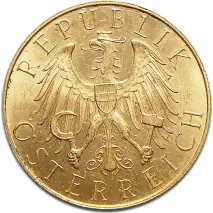Gold Austrian Schilling
Buy Austrian Gold Schilling coins in the UK
Invest in Austrian Gold Schilling coins with StoneXBullion, your trusted platform for buying gold bullion in the UK and Europe. Since 2006, we’ve helped over 100,000 investors buy and sell gold online, with secure checkout, competitive spreads, and prices updated every 60 seconds.
All Austrian Gold Schilling coins sold by StoneXBullion are fully authenticated and shipped in discreet packaging with insured delivery across the UK and Europe.
What is the Austrian Gold Schilling coin?
The Austrian Gold Schilling was a coin issued by the Austrian Mint in 1926 and used as Austria's official currency until 1938.
Key features of Austrian Gold Schilling coins:
- Typically 900 or higher purity gold, depending on the issue
- Struck by one of the world’s oldest continuously operating mints, the Austrian Mint
- Historic European legal tender
- VAT-free in the UK.
The coin's designs vary depending on the denomination and year, but often feature the Austrian coat of arms, edelweiss flowers, imperial eagle, or Austrian cultural figures such as St. Leopold, the patron saint of Austria.
Gold Schilling vs regular Schilling coins
The Schilling was Austria’s currency used until the euro was introduced in 2002. Most of these circulating coins were base metals and NOT made from gold.
When buying investment Schillings, be sure to look for Gold Schilling coins issued between 1926 and 1938, as well as special commemorative and bullion issues struck in high-purity gold. At StoneXBullion, we only sell investment-grade Gold Schilling coins.
Why invest in Austrian Gold Schillings?
Austrian Gold Schillings offer a blend of bullion value with collectible appeal thanks to their history as circulating currency. Here’s why they make a great investment:
- Competitive pricing: Typically lower premiums than modern bullion coins
- VAT-free in the UK: As investment-grade gold, Austrian Schillings are exempt from VAT
- Good liquidity: The coins are widely recognised across Europe, making them easy to sell
- Historic relevance: Austrian Gold Schillings represent a period in Austrian history
- Diversification & inflation hedge: Gold has traditionally been valued for its ability to act as an inflation hedge and portfolio diversifier.
Popular Austrian Gold Schilling coin sizes
Austrian Gold Schillings were minted in four main denominations: 25, 100, 500, and 1,000 Schillings.
1,000 Schilling Gold Coins (1976)
The 1,000 Schilling gold coin was minted to commemorate the 1,000th anniversary of the Babenberg Dynasty.
- Purity: 90%
- Gold content: 13.35 grams
- Design: Imperial eagle with Austrian shield on the obverse, Seal of Duke Friedrich on the reverse.
100 Schilling Gold Coins
- Purity: 90%
- Gold content: Approx. 21.17 grams
- Design: Imperial eagle with Austrian shield on obverse, date and coin's value flanked by edelweiss sprays on the reverse.
25 Schilling Gold Coins
- Purity: 90%
- Gold content: 5.29 grams
- Design: Imperial eagle with Austrian shield on obverse, date and coin's value flanked by edelweiss sprays on the reverse.
How to buy Austrian Gold Schilling coins in the UK
Buying Austrian Gold Schillings with StoneXBullion is quick, easy, and secure:
- Browse our selection: Choose from 25, 100, 500, and 1,000 Schilling coins depending on availability
- Check live pricing: Our gold prices are updated every 60 seconds based on the London Bullion Market Association (LBMA)
- Pay securely: Complete payment via bank transfer or credit card
- Receive insured delivery: All orders are discreetly packaged and fully insured for delivery across the UK and Europe.
Austrian Gold Schillings: FAQs
Are Austrian Gold Schillings VAT-free in the UK?
Yes, Austrian Gold Schillings are classed as investment-grade gold, making them VAT-free in the UK.
What purity are Gold Schilling coins?
Most Gold Schillings are struck from .900 purity, though you can also find commemorative schillings in .986 or .9999 purity.
Are Austrian Gold Schillings a good investment?
Yes, Austrian Gold Schillings offer strong liquidity and historical appeal.
Are all Schillings made from gold?
No, most circulating Schilling coins were made from base metals. Gold Schillings were only minted between 1926 and 1938 as well as special commemorative and bullion issues released by the Austrian Mint.
Invest in Austrian Gold Schilling coins today
Buy Austrian Gold Schillings online with StoneXBullion, trusted by more than 100,000 investors across the UK and Europe. Enjoy live pricing, secure checkout, and fully insured delivery direct to your door.
Browse our full range of Gold Schillings and start your gold investment journey today.

